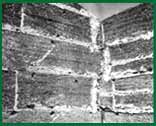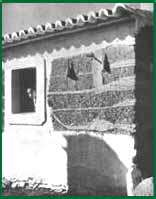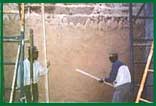|
|
 |

Taipa
(Clay mixed with sand grains and pebbles, beated with a sledgehammer,
and sometimes compreesed between pillars croossed by narrow strips of
wood). It is a millenary construction system that was used in our country
until the middle of the century to build houses, mainly in the Alentejo
and Algarve regions.
The necessary step to do the "taipa" mass
as it should be done, is empirically determined in the region by the old
experience of using the material. Choosing the earth as not all earth
possesses suffcient natural proprieties.
It is formed by wet earth compressed between
removable wooden molds, that are removed after it is completely dried,
thus forming a wall of unburnable, naturally isothermal and quite cheap
material.
The disadvantages are its vulnerability to
the attacks of rodents and lack of stability as far as earthquakes and
lateral strain caused by covering weight fluency is concerned. To counter
these weaknesses they were frequently reinforced introducing abutments
or buttresses. So it was not suitable for the construction of big buildings.
"Taipa" should only be plastered and treated
with burned lime plasters or through direct whitewashing so as to be protected
against the influence of the atmosphere, especially against water.
As it is easily ruined by water, it could
only be made upon normal stone foundations, generally schist about 0,60cm
above the ground, from which the wall was built. Thus avvoinding rising
humidity.
|
|
 


|


